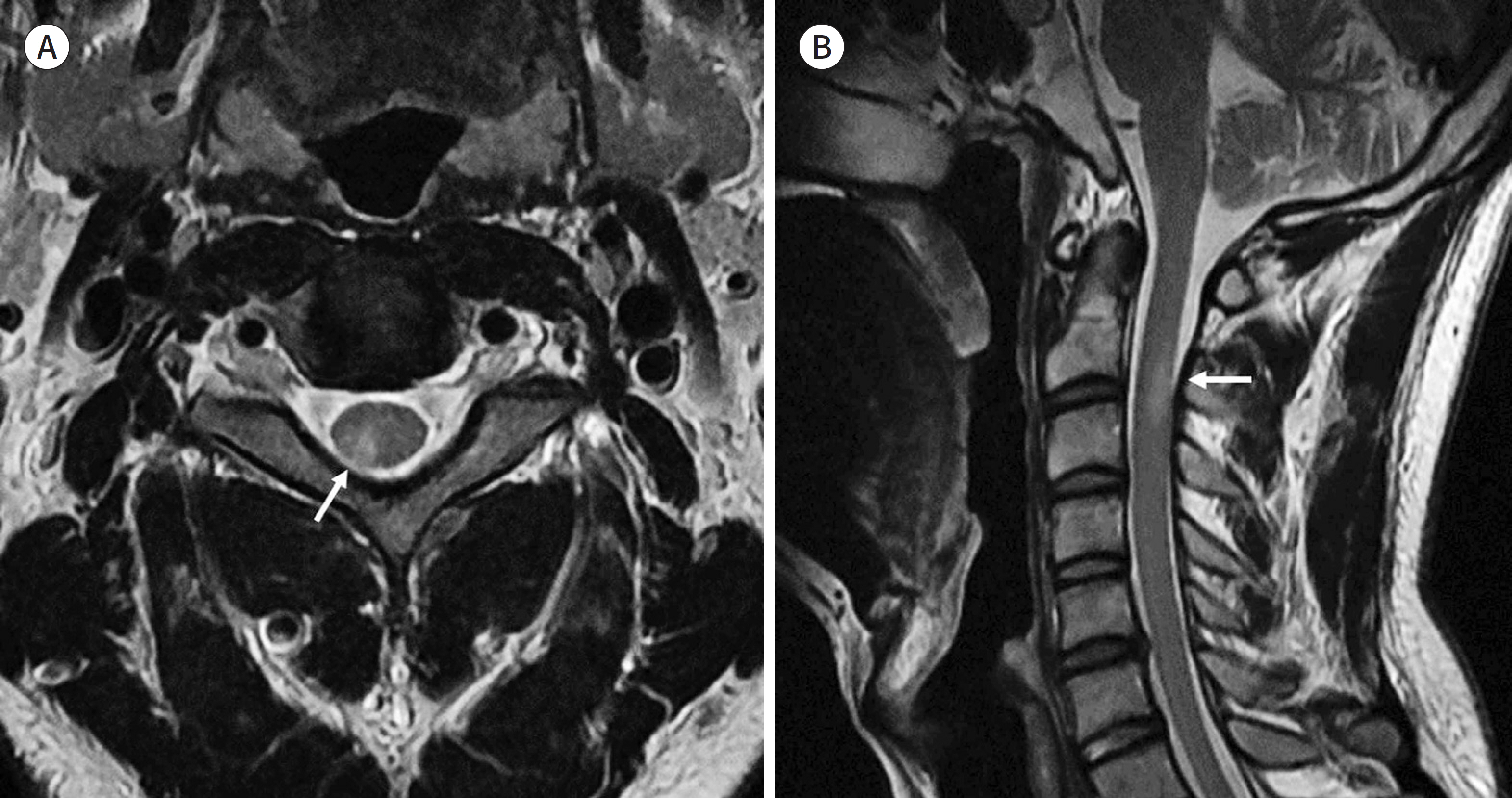J Korean Soc Radiol.
2020 Jan;81(1):135-146. 10.3348/jksr.2020.81.1.135.
Various MRI Findings of Toxocara canis Myelitis
- Affiliations
-
- 1Department of Radiology, Seoul National University Bundang Hospital, Seongnam, Korea. eugene801027@gmail.com
- 2Department of Neurology, Seoul National University Bundang Hospital, Seongnam, Korea.
- KMID: 2469187
- DOI: http://doi.org/10.3348/jksr.2020.81.1.135
Abstract
- PURPOSE
To describe magnetic resonance imaging (MRI) findings in 10 cases of Toxocara canis myelitis and to analyze these findings to aid in the diagnosis of this condition.
MATERIALS AND METHODS
From June 2015 to March 2018, we retrospectively analyzed the electronic medical records and MR images of patients who were diagnosed with Toxocara canis myelitis. The analysis of the MR images was based on a discussion between an experienced spinal radiologist and a radiology resident.
RESULTS
This study classified MRI findings into the following two types. Type 1 was defined as central and diffuse T2 high signal intensity on the axial plane, which was observed in 50% of all cases. All lesions showed avid enhancement, mostly in the posterolateral or posterior region (4 cases, 80%). Type 2 was defined as wedge-shaped or focal T2 high signal intensity in the posterolateral or posterior region and corresponded to the remaining 50% of the cases. In this case, the extent of the lesion was relatively small and contrast enhancement was observed in only one case.
CONCLUSION
This study revealed that various imaging findings could be observed in cases of Toxocara canis myelitis, and the findings were classified into two types.
MeSH Terms
Figure
Reference
-
1. Finsterer J, Auer H. Neurotoxocarosis. Rev Inst Med Trop Sao Paulo. 2007; 49:279–287.
Article2. Eberhardt O, Bialek R, Nägele T, Dichgans J. Eosinophilic meningomyelitis in toxocariasis: case report and review of the literature. Clin Neurol Neurosurg. 2005; 107:432–438.
Article3. Jabbour RA, Kanj SS, Sawaya RA, Awar GN, Hourani MH, Atweh SF. Toxocara canis myelitis: clinical features, magnetic resonance imaging (MRI) findings, and treatment outcome in 17 patients. Medicine (Baltimore). 2011; 90:337–343.4. Lee IH, Kim ST, Oh DK, Kim HJ, Kim KH, Jeon P, et al. MRI findings of spinal visceral larva migrans of Toxocara canis. Eur J Radiol. 2010; 75:236–240.
Article5. Hiramatsu Y, Yoshimura M, Saigo R, Arata H, Okamoto Y, Matsuura E, et al. Toxocara canis myelitis involving the lumbosacral region: a case report. J Spinal Cord Med. 2017; 40:241–245.
Article6. Goffette S, Jeanjean AP, Duprez TP, Bigaignon G, Sindic CJ. Eosinophilic pleocytosis and myelitis related to Toxocara canis infection. Eur J Neurol. 2000; 7:703–706.7. Umehara F, Ookatsu H, Hayashi D, Uchida A, Douchi Y, Kawabata H, et al. MRI studies of spinal visceral larva migrans syndrome. J Neurol Sci. 2006; 249:7–12.
Article8. Xinou E, Lefkopoulos A, Gelagoti M, Drevelegas A, Diakou A, Milonas I, et al. CT and MR imaging findings in cerebral toxocaral disease. AJNR Am J Neuroradiol. 2003; 24:714–718.9. Ma G, Holland CV, Wang T, Hofmann A, Fan CK, Maizels RM, et al. Human toxocariasis. Lancet Infect Dis. 2018; 18:e14–e24.
Article10. Sheerin F, Collison K, Quaghebeur G. Magnetic resonance imaging of acute intramedullary myelopathy: ra-diological differential diagnosis for the on-call radiologist. Clin Radiol. 2009; 64:84–94.
Article11. Wingerchuk DM, Banwell B, Bennett JL, Cabre P, Carroll W, Chitnis T, et al. International consensus diagnos-tic criteria for neuromyelitis optica spectrum disorders. Neurology. 2015; 85:177–189.
Article12. Jacob A, Weinshenker BG. An approach to the diagnosis of acute transverse myelitis. Semin Neurol. 2008; 28:105–120.
Article13. Kumar J, Kimm J. MR in Toxocara canis myelopathy. AJNR Am J Neuroradiol. 1994; 15:1918–1920.
- Full Text Links
- Actions
-
Cited
- CITED
-
- Close
- Share
- Similar articles
-
- Toxocara canis-Associated Myelitis with Eosinophilic Pneumonia
- Eosinophilic Myelitis Associated With Toxocariasis
- Characteristics of Atopic Myelitis and its Relationship With Toxocara Canis Myelitis
- Eosinophilic Myocarditis Associated with Visceral Larva Migrans Caused by Toxocara Canis Infection
- Prevalence of Toxocara canis in Dogs, North West Bank of Palestine





